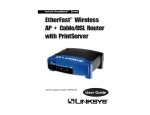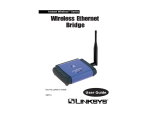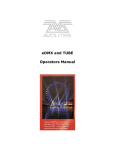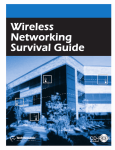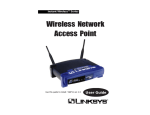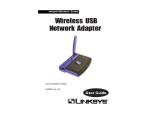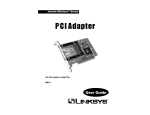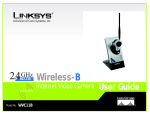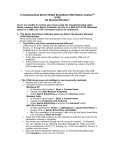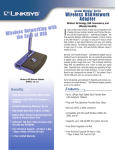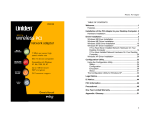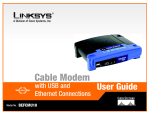Download Linksys NULL WUSB11 User's Manual
Transcript
Instant WirelessTM Series Wireless USB Network Adapter Use this guide to install: WUSB11 ver. 2.6 User Guide COPYRIGHT & TRADEMARKS Copyright © 2002 Linksys, All Rights Reserved. Microsoft, Windows, and the Windows logo are registered trademarks of Microsoft Corporation. All other trademarks and brand names are the property of their respective proprietors. LIMITED WARRANTY Linksys guarantees that every Instant Wireless™ USB Network Adapter will be free from physical defects in material and workmanship under normal use for one year from the date of purchase, when used within the limits set forth in the Specifications chapter of this User Guide. If these products prove defective during this warranty period, call Linksys Technical Support in order to obtain a Return Authorization Number. BE SURE TO HAVE YOUR PROOF OF PURCHASE AND A BARCODE FROM THE PRODUCT'S PACKAGING ON HAND WHEN CALLING. RETURN REQUESTS CANNOT BE PROCESSED WITHOUT PROOF OF PURCHASE. When returning a product, mark the Return Authorization Number clearly on the outside of the package and include a copy of your original proof of purchase. All customers located outside of the United States of America and Canada shall be held responsible for shipping and handling charges. IN NO EVENT SHALL LINKSYS’S LIABILITY EXCEED THE PRICE PAID FOR THE PRODUCT FROM DIRECT, INDIRECT, SPECIAL, INCIDENTAL, OR CONSEQUENTIAL DAMAGES RESULTING FROM THE USE OF THE PRODUCT, ITS ACCOMPANYING SOFTWARE, OR ITS DOCUMENTATION. LINKSYS DOES NOT OFFER REFUNDS FOR ANY PRODUCT. Linksys makes no warranty or representation, expressed, implied, or statutory, with respect to its products or the contents or use of this documentation and all accompanying software, and specifically disclaims its quality, performance, merchantability, or fitness for any particular purpose. Linksys reserves the right to revise or update its products, software, or documentation without obligation to notify any individual or entity. Please direct all inquiries to: Linksys P.O. Box 18558, Irvine, CA 92623. FCC STATEMENT This Instant Wireless™ USB Network Adapter has been tested and complies with the specifications for a Class B digital device, pursuant to Part 15 of the FCC Rules. These limits are designed to provide reasonable protection against harmful interference in a residential installation. This equipment generates, uses, and can radiate radio frequency energy and, if not installed and used according to the instructions, may cause harmful interference to radio communications. However, there is no guarantee that interference will not occur in a particular installation. If this equipment does cause harmful interference to radio or television reception, which is found by turning the equipment off and on, the user is encouraged to try to correct the interference by one or more of the following measures: • • • • Reorient or relocate the receiving antenna Increase the separation between the equipment or devices Connect the equipment to an outlet other than the receiver’s Consult a dealer or an experienced radio/TV technician for assistance FCC Caution: Any changes or modifications nor expressly approved by the party responsible for compliance could void the user's authority to operate this equipment. This device complies with Part 15 of the FCC Rules. Operation is subject to the following two conditions: (1) This device may not cause harmful interference, and (2) This device must accept any interference received, including interference that may cause undesired operation. FCC RF Radiation Exposure Statement This device and its antenna(s) must operate with a separation distance of at least 20 cm from all persons and must not be co-located or operating in conjunction with any other antenna or transmitter. End-users must be provided with specific operations for satisfying RF exposure compliance. UG-WUSB11 ver. 2.6-032002 BW Instant WirelessTM Series Wireless USB Network Adapter Table of Contents Chapter 1: Introduction The Instant WirelessTM USB Network Adapter Features Package Contents System Requirements 1 1 1 2 2 Appendix A: Troubleshooting Common Problems and Solutions Frequently Asked Questions 29 29 29 Appendix B: Glossary 33 Chapter 2: Planning Your Wireless Network Network Topology Roaming 3 3 3 Appendix C: Specifications 38 Appendix D: Environmental 39 Chapter 3: Getting To Know the Wireless USB Network Adapter The Wireless USB Network Adapter’s Port and LEDs Appendix E: Warranty Information 40 4 4 Appendix F: Contact Information 41 Chapter 4: Installation and Configuration of the USB Adapter for Windows 98SE, Me, and 2000 Software and Driver Installation for Windows 98SE, Me, and 2000 6 7 Chapter 5: Connecting Your Wireless USB Network Adapter The USB Icon USB Cabling Removing the USB Adapter Using the Wireless USB Network Adapter’s Wall Mount Hardware Detection for Windows 98SE, Me, and 2000 12 12 12 13 13 15 Chapter 6: Installation of the USB Adapter for Windows XP Windows XP Wireless Zero Configuration 16 18 Chapter 7: Installing Network Protocols Installing the Network Protocols for Windows 98SE and Me 21 21 Chapter 8: Configuring the Wireless USB Network Adapter 23 Instant WirelessTM Series Chapter 1: Introduction Wireless USB Network Adapter Package Contents The Instant WirelessTM USB Network Adapter Put the “mobile” back into mobile computing with the Linksys Instant Wireless™ USB Network Adapter! The Linksys Instant Wireless™ USB Network Adapter operates in the ISM band, using Direct Sequence Spread Spectrum (DSSS) transmission to implement the 802.11b standard. Users can now move easily between Access Points without the hassle of reconfiguring their connection. The Instant Wireless™ USB Network Adapter also gives you the freedom to work your way, from where you want, letting you take full advantage of your PC and providing you with access to all your networked resources from beyond your desktop, and a high-powered built-in antenna with LEDs indicates power and linkage. Compatible with Windows 98SE, 2000, Me, and XP, the Instant Wireless™ USB Network Adapter from Linksys is a true necessity for all your wireless PC applications. Features • • • • • • • • • • • • • 1 Up to 11 Mbps High-Speed Data Transfer Rate Integrated Equalizer Recovers Weak Signals and Enhances Sensitivity Movable External Antenna Improves Signal Quality USB Port Powers Your Adapter—No Power Supply Needed! Compatible with Windows 98SE, Me, 2000, and XP User-Friendly Setup Software Provides Hassle-Free Configuration Plug-and-Play Operation Provides Easy Setup Works with All Standard Internet Applications Interoperable with 802.11b (DSSS) 2.4GHz-Compliant Equipment Capable of up to 128-Bit WEP Encryption Free Software Driver Upgrades Toll-Free Technical Support—24 Hours a Day, 7 Days a Week for U.S. Only 1-Year Limited Warranty Figure 1-1 • • • • • • One Wireless USB Network Adapter One USB Cable One Wall Mount One Setup CD-ROM with User Guide One Quick Installation One Registration Card System Requirements • • • • • Pentium-Class 200MHz or Faster Processor 64MB RAM Recommended Available USB Port CD-ROM Drive Windows 98SE, Me, 2000, XP 2 Instant WirelessTM Series Wireless USB Network Adapter Chapter 2: Planning Your Wireless Network Chapter 3: Getting to Know the Wireless USB Network Adapter Network Topology The Wireless USB Network Adapter’s Port and LEDs A wireless LAN is exactly like a regular LAN, except that each computer in the LAN uses a wireless device to connect to the network. Computers in a wireless LAN must be configured to share the same frequency channel. The Wireless USB Network Adapter’s USB port is located on the back of the Adapter. The Instant Wireless™ USB Network Adapter provides access to a wired LAN for wireless workstations. An integrated wireless and wired LAN is called an Infrastructure configuration. A group of Instant Wireless™ USB Network Adapter users and an Access Point compose a Basic Service Set (BSS). Each PC equipped with an Instant Wireless™ USB Network Adapter in a BSS can talk to any computer in a wired LAN infrastructure via the Access Point. Figure 3-1 An infrastructure configuration extends the accessibility of an Instant Wireless™ USB Network Adapter PC to a wired LAN, and doubles the effective wireless transmission range for two Instant Wireless™ USB Network Adapter PCs. Since the Access Point is able to forward data within its BSS, the effective transmission range in an infrastructure LAN is doubled. The use of a unique ID in a BSS is essential. All computers that have Instant Wireless™ USB Network Adapter configured without roaming options in an independent BSS must be configured with a BSS ID (that is used in the BSS). The Wireless USB Network Adapter’s USB port USB Port The USB Port is a port installed in your PC, enabling you to connect to USB peripherals. To work with USB ports, your PC must be running Windows 98SE, Me, 2000, or XP. Your Wireless USB Network Adapter comes with a USB cable. Plug one end into your PC’s USB port and the other end into your Wireless USB Network Adapter. The Wireless LAN Infrastructure configuration is appropriate for enterprisescale wireless access to a central database, or as a wireless application for mobile users. Roaming Infrastructure mode also supports roaming capabilities for mobile users. More than one BSS can be configured as an Extended Service Set (ESS). This continuous network allows users to roam freely within an ESS. All Instant Wireless™ USB Network Adapter PCs within one ESS must be configured with the same ESS ID and use the same radio channel. Before enabling a network with roaming capability, selecting a feasible radio channel and optimum Access Point position is recommended. Proper Access Point positioning combined with a clear radio signal will greatly enhance performance. 3 4 Instant WirelessTM Series Note: Windows 95 and NT do not support the USB Adapter. Wireless USB Network Adapter Chapter 4: Installation and Configuration of the USB Adapter for Windows 98SE, Me, and 2000 This Wireless USB Network Adapter Setup Wizard will guide you through the Install and Uninstall Procedures for Windows 98SE, Me, and 2000. Important for Windows XP users: Do NOT run the Wireless Network Adapter Setup Wizard. Proceed directly to Chapter 5: Connecting Your Wireless USB Network Adapter. Note to Windows 98, Me, and 2000 users: You must install this software before installation of the hardware. Figure 3-2 Insert the Setup Wizard CD into your CD-ROM Drive. The Setup Wizard should run automatically and Figure 4-1 should appear. If it does not, click the Start button and choose Run. In the box that appears, enter D:\setup.exe (where “D” is the letter of your CD-ROM drive). The LED Indicators Power Green. The Power LED lights up when the Wireless USB Network Adapter is powered on. Link Green. The Link LED lights up when the Adapter has an active connection. If the LED is not on, the Adapter is not interfacing with the network. Figure 4-1 5 6 Instant WirelessTM Series • The Setup button begins the software installation process, as shown on the next page. • The User Guide button shows you a PDF file of the User Guide. • The LINKSYS WEB button links you to the Linksys website. • The Exit button allows you to the exit the Setup Wizard. Wireless USB Network Adapter 3. After reading the Warranty Policy, click the Yes button if you agree, or No to end the installation. Software and Driver Installation for Windows 98SE, Me, and 2000 1. To install your Wireless USB Network Adapter, click on the Setup button. 2. After you see Figure 4-2, click the Next button to continue. Figure 4-3 4. The InstallShield Wizard will automatically choose the folder where Setup Wizard will install the files. Click the Next button. Figure 4-2 Figure 4-4 7 8 Instant WirelessTM Series 5. The InstallShield Wizard will ask you to choose a wireless mode. Choose the mode that applies to your network. Ad-Hoc Mode is used for simple peer-to-peer networking or the sharing of local resources between wireless Networked PCs, and Infrastructure Mode allows a wireless network to be integrated into an existing, wired network through an access point, permitting roaming between access points while maintaining a connection to all network resources. Then, click the Next button. Wireless USB Network Adapter 7. Enter in the name of your SSID (Service Set Identifier) for your Ad-Hoc or Infrastructure setting. The SSID must be identical for all points in the network. The default setting is linksys (all lowercase). Click the Next button. Figure 4-7 Figure 4-5 6. If you chose Infrastructure Mode, go on to Step 7 now. If you chose AdHoc Mode, choose the correct operating channel that applies to your network. The channel you choose should be the same as the other points in your wireless network. The default channel is set to Channel 6. Click Next. Figure 4-6 9 8. The Wizard will ask you to review your settings before starting to copy files. Select Back to review or change any settings, or select Next if you are satisfied with your settings. Figure 4-8 10 Instant WirelessTM Series 9. The InstallShield Wizard will begin copying the files. The bar in the middle of the screen below shows the percentage of files copied. Wireless USB Network Adapter Chapter 5: Connecting Your Wireless USB Network Adapter Important for Windows 98SE, Me, and 2000 users: You must install the Adapter’s software before installation of the hardware. Important for Windows XP users: You must install the Adapter’s hardware before installation of the software. Figure 4-9 10. The screen in Figure 410 may appear. Click on the Yes button if you want to continue the installation. Click on the No button if you do not want to continue the installation. 11. After the Wireless USB Network Adapter Setup Wizard has been successfully installed, the screen in Figure 4-10 will appear. To install your Wireless USB Network Adapter, first connect one end of the USB cable to the Adapter. Then, connect the other end of the USB cable to the USB port on your desktop or notebook PC. Since the Adapter gets its power from the PC’s USB port, there is no external power adapter. The Power LED should light up green when the Adapter is attached and the PC is on. The USB Icon The USB icon shown below marks a USB port on a PC or device. Figure 5-1 Figure 4-10 USB Cabling The Wireless USB Network Adapter comes with one USB cable. Connect one end of the USB cable to the USB device on your USB Network Adapter. Connect the other end to a computer’s USB port. You have now completed the installation of your Wireless USB Network Adapter Setup Wizard. To connect the Wireless USB Network Adapter, please go to Chapter 5: Connecting Your Wireless USB Network Adapter. The picture shows two USB ports as they might appear on your computer. Note the two USB icons marking the ports. Figure 5-2 Figure 4-11 11 12 Instant WirelessTM Series Removing the Wireless USB Network Adapter Wireless USB Network Adapter STEP TWO The adapter is Hot Swappable, which means that you can remove or reconnect the adapter whenever you want without turning off your PC. Although, you might need to renew your network connection Note: If you have multiple USB ports on your PC, make sure to reconnect the adapter into the same port that it was removed; otherwise, the adapter will be detected as a new device. Using the Wireless USB Network Adapter’s Wall Mount The Wireless USB Network Adapter’s Wall Mount allows you to easily install the Wireless USB Network Adapter onto your wall for convenient use and better reception. Before installing the Wall Mount into the Wireless USB Network Adapter, take the separate adhesive strip of velcro and attach it to the wall where you will be mounting the Wireless USB Network Adapter. The Wall Mount, shown in Figure 5-3, is included with the Wireless USB Network Adapter. Figure 5-5 STEP THREE Figure 5-3 To install it into the Wireless USB Network Adapter, simply slide it into the Adapter’s back, as shown in steps one, two, and three. STEP ONE Figure 5-6 Figure 5-4 13 Once the Wall Mount is attached to the Wireless USB Network Adapter, stick it to the velcro strip you’ve attached to your wall for wall mounting. 14 Instant WirelessTM Series Hardware Detection for Windows 98SE, Me, and 2000 After the Wireless USB Network Adapter has been physically connected to your computer, Windows will detect the new hardware. You may see the screen in Figure 5-7. Click on the Yes button to continue or the No button to stop the installation. Wireless USB Network Adapter Chapter 6: Installation and Configuration of the USB Drivers for Windows XP After attaching the Wireless USB Network Adapter to your computer, you will install the network driver. Important for Windows XP users: Do NOT run the Wireless Network Adapter Setup Wizard. If the Setup Wizard runs automatically after the Setup Wizard CD has been inserted, click the Exit tab. 1. Windows XP will automatically detect the presence of the Wireless USB Network Adapter in your computer. Insert the Setup Wizard CD into your CD-ROM Drive. Click the radio button next to Install from a list or specific location (Advanced). Then click the Next button to continue. Figure 5-7 In most cases, Windows will then automatically copy all of the files needed for networking. If Windows asks you for the files, and D is your computer’s CDROM drive, they may be located at: D:\Drives These files may also be located at C:\windows\options\cabs. Check with your operating system’s user guide for the exact location. Note to Windows 2000 Users: You may be prompted at this time that a digital signature has not been found; this is normal. See Figure 5-7. The WUSB11 has been verified to run on Windows 2000. Click Yes to continue, and then click the Finish button to end the hardware detection process. Important for Windows XP users: After the Wireless USB Network Adapter has been physically connected to your computer, Windows will detect the new hardware. Proceed to Chapter 6: Installation and Configuration of the USB Adapter for Windows XP. 15 Figure 6-1 16 Instant WirelessTM Series 2. Click the radio button next to Search for the best driver in these locations. Select Include this location in the search:, and enter D:\Drivers in the location field (if “D” is the letter of your CD-ROM drive). Click the Next button. Figure 6-2 Wireless USB Network Adapter 4. Windows will tell you when it has finished installing the new driver. Click the Finish button. Figure 6-4 3. Windows will notify you that the driver has not passed Windows Logo testing. Since this product has been tested to work with Windows XP, click the Continue Anyway button. You have now completed the installation of the drivers for the Wireless USB Network Adapter. Windows XP Wireless Zero Configuration Important for Windows XP users: Windows XP has built-in configuration tools. Use the Windows XP Wireless Zero Configuration, (in the system tray at the bottom of your screen) to configure the Adapter. 1. After installing the Adapter, the Windows XP Wireless Zero Configuration icon will appear on your system tray. See Figure 6-5. Double-click the icon of the two monitors and Figure 6-6 will appear. Figure 6-3 17 18 Instant Broadband Series Wireless USB Network Adapter 3. If your Access Point has enabled WEP encryption, the screen in Figure 6-7 will appear. Enter the WEP key in the Network Key. Click the Connect button. Figure 6-5 2. The screen that appears will show any available Network. Network, then click on the connect button. Select a Figure 6-7 In order to find out the WEP encryption set by other wireless products in your network, such as the WAP11, you may run the USB utility or SNMP configuration program to check the WEP encryption tab for the correct key entries. If you are using other access points, please check their user guides for more information on WEP encryption configuration. Note: Windows XP does not support the use of a passphrase. Enter the exact key used on your access point. 4. The screen in Figure 6-8 will appear next if your connection is successful. Figure 6-8 Figure 6-6 19 For more information about WEP, refer to the Router’s User Guide or the KnowledgeBase on the Linksys Website. For further information on Wireless Networking with Windows XP, search the Windows XP Search Engine using the keyword: “wireless.” 20 Instant WirelessTM Series Chapter 7: Installing Network Protocols Wireless USB Network Adapter 2. From the Configuration tab, select Instant Wireless USB Network Adapter ver. 2.6 from the list, and click the Add button. Protocols are necessary for computers to be recognized on your network. Windows 2000 and XP users need to check their Windows User Guides for protocol installation. Installing the Network Protocols for Windows 98SE and Me 1. From the Start Menu, select Settings and bring up the Control Panel. From the Control Panel, double-click on the Network icon. Figure 7-2 3. Select Protocol, and click the Add button. Figure 7-3 Figure 7-1 Note: Before adding any network protocols, verify that the protocol is not already installed. Never install duplicate protocols. 21 4. Select Microsoft from the list of “Manufacturers” and TCP/IP from the list of “Network Protocols.” Click the OK button to close the Network window. Windows may start copying some files or ask you for your Windows installation files at this time. After the files are copied, Windows may ask you to restart. Click Yes to restart and complete the installation process. Figure 7-4 22 Instant WirelessTM Series Chapter 8: Configuring the Wireless USB Network Adapter After installing the Network Adapter, Windows 98SE, Me, 2000, and XP will automatically identify the Adapter. Next, you may need to configure the Adapter’s driver software. Important for Windows XP users: Windows XP has built-in configuration tools. Use the Windows XP Wireless Zero Configuration, (in the system tray at the bottom of your screen) to configure the Adapter See Chapter 6: Installation and Configuration of the USB Drivers for Windows XP. Wireless USB Network Adapter 2. The screen in Figure 8-3 shows you any available wireless device for network connection. Select the wireless device, and click the Connect button to connect or the Refresh button to search for more wireless devices. Attempt Auto-Connect to ANY network in range will connect you to the closest network within range. Click the X (Close) button in the upper right corner to close the WLAN Monitor or click the P r o f i l e Setting button to continue. 1. After installing the Adapter, the Wireless USB Network Adapter WLAN Monitor icon will appear on your system tray. Double-click on the icon of the monitor in Figure 8-1, and Figure 8-2 will appear: Figure 8-1 Figure 8-3 3. When the screen in Figure 8-4 appears, click on the New button to create a new profile or select a profile and click on the edit button to change an existing profile or Click on the Delete button to delete a profile. Select a profile and click the Connect button to connect. Figure 8-2 Figure 8-2 shows you the status of your current connection on the Link Status page. Click the X (Close) button in the upper right corner to close the WLAN Monitor or click the Connections button to continue. 23 Figure 8-4 24 Instant WirelessTM Series 4. If you click on the New or Edit button, the screen in Figure 8-5 will appear. You can enter a name for a new profile and change any of the settings on this page. Figure 8-5 Wireless USB Network Adapter 5. If you clicked on the Advance button, the Advanced page will appear. Under the WEP drop-down box, you can choose to have WEP encryption Disabled, 64, or 128 Bits. If you choose 64 Bits, the screen in Figure 8-6 will appear. If you choose 128 Bits, the screen in Figure 8-7 will appear. Figure 8-6 Under the Network Type, you may choose either Infrastructure or Ad-Hoc. Infrastructure mode allows a wireless adapter to communicate with a wired network employing an access point, while the Ad-Hoc mode allows wireless-to-wireless, peer-to-peer communication. If you choose Infrastructure, the SSID should have the same name as the Access Point. If you choose AdHoc, all clients should share the same SSID name. Click the Apply button to save the settings or click on the Advanced button for your WEP encryption settings. Figure 8-7 25 26 Instant WirelessTM Series Wired Equivalent Privacy (WEP) is an encryption scheme used to protect wireless data communication. The Disabled setting prevents the sharing of data with other computers on the WEP network. There are two ways to create WEP Encryption keys. The first method is by typing a Passphrase into that field and clicking the Generate button. This will generate WEP Encryption keys based upon that passphrase. A second method is to type the WEP Encryption keys in the available fields manually. When manually typing the keys, you must use Hexadecimal characters, which are the letters “A” through “F” and the numbers “0” through “9”. To find out the WEP encryption set by other wireless products in your network, such as the WAP11, you may run the USB utility or SNMP configuration program to check the WEP encryption tab for the correct key entries. If you are using other access points, please check their user guides for more information on WEP encryption configuration. Wireless USB Network Adapter 6. The About tab, as shown in Figure 8-8, shows you copyright and version information about the driver, the application, and the firmware. The version number of the driver may vary from this screen, depending on which version was shipped with your Adapter. You can always visit www.linksys.com for the latest version of the driver. Click the X (Close) button in the upper right corner to complete the WLAN Monitor. Important: This hexadecimal number must match the Key on all other devices on the wireless network, or this device will be unable to transmit or receive data. In the bottom drop-down box , choose which Default Key will be used for the encryption. By default, Key 1 will be used. Click the Apply button when you are done. Figure 8-8 27 28 Instant WirelessTM Series Appendix A: Troubleshooting Wireless USB Network Adapter Can I play computer games with other members of the wireless network? Yes, as long as the game supports multiple players over a LAN (local area network). Refer to the game’s user guide for more information. Common Problems and Solutions This chapter provides solutions to problems usually occurring during the installation and operation of the USB Network Adapter. Read the description below to solve your problems. If you can’t find an answer here, check the Linksys website at www.linksys.com. 1. My computer does not recognize the Wireless USB Network Adapter. • Make sure that the Wireless USB Network Adapter is properly inserted into the USB port. • Also, make sure that the USB Controller is enabled in the BIOS. Check with your motherboard User Guide for more information. 2. The Wireless USB Network Adapter does not work properly. • Reinsert the Wireless USB Network Adapter into the notebook or desktop’s USB port. • For Windows 98SE or Me, right-click on My Computer, and select Properties. Select the Device Manager tab, and click on the Network Adapter. You will find the Wireless USB Network Adapter if it is installed successfully. If you see a yellow exclamation mark, the resources may be conflicting and you must follow the steps below: • Uninstall the driver software from your PC. • Restart your PC and repeat the hardware and software installation as specified in this User Guide. 3. I cannot communicate with the other computers linked via Ethernet in the Infrastructure configuration. • Make sure that the notebook or desktop is powered on. • Make sure that your Wireless USB Network Adapter is configured on the same channel, SSID, and WEP as the other computers in the Infrastructure configuration. Frequently Asked Questions Can I run an application from a remote computer over the wireless network? This will depend on whether or not the application is designed to be used over a network. Consult the application's user guide to determine if it supports operation over a network. 29 What is the IEEE 802.11b standard? The IEEE 802.11b Wireless LAN standards subcommittee, which is formulating a standard for the industry. The objective is to enable wireless LAN hardware from different manufacturers to communicate. What IEEE 802.11 features are supported? The product supports the following IEEE 802.11b functions: • CSMA/CA plus Acknowledge protocol • Multi-Channel Roaming • Automatic Rate Selection • RTS/CTS feature • Fragmentation • Power Management What is Ad-hoc? An Ad-hoc wireless LAN is a group of computers, each with a WLAN adapter, connected as an independent wireless LAN. Ad-hoc wireless LAN is applicable at a departmental scale for a branch or SOHO operation. What is Infrastructure? An integrated wireless and wired LAN is called an Infrastructure configuration. Infrastructure is applicable to enterprise scale for wireless access to a central database, or wireless application for mobile workers. What is Roaming? Roaming is the ability of a portable computer user to communicate continuously while moving freely throughout an area greater than that covered by a single Access Point. Before using the roaming function, the workstation must make sure that it is the same channel number with the Access Point of dedicated coverage area. To achieve true seamless connectivity, the wireless LAN must incorporate a number of different functions. Each node and Access Point, for example, must always acknowledge receipt of each message. Each node must maintain contact with the wireless network even when not actually transmitting data. Achieving these functions simultaneously requires a dynamic RF networking technology that links Access Points and nodes. In such a system, the user’s end node undertakes a search for the best possible access to the system. First, it evaluates such 30 Instant WirelessTM Series factors as signal strength and quality, as well as the message load currently being carried by each Access Point and the distance of each Access Point to the wired backbone. Based on that information, the node next selects the right Access Point and registers its address. Communications between end node and host computer can then be transmitted up and down the backbone. As the user moves on, the end node’s RF transmitter regularly checks the system to determine whether it is in touch with the original Access Point or whether it should seek a new one. When a node no longer receives acknowledgment from its original Access Point, it undertakes a new search. Upon finding a new Access Point, it then reregisters, and the communication process continues. What is BSS ID? A specific Ad hoc LAN is called a Basic Service Set (BSS). Computers in a BSS must be configured with the same BSS ID. What is ESS ID? An Infrastructure configuration could also support roaming capability for mobile workers. More than one BSS can be configured as an Extended Service Set (ESS). Users within an ESS could roam freely between BSSs while served as a continuous connection to the network wireless stations, and Access Points within an ESS must be configured with the same ESS ID and the same radio channel. What is ISM band? The FCC and their counterparts outside of the U.S. have set aside bandwidth for unlicensed use in the ISM (Industrial, Scientific and Medical) band. Spectrum in the vicinity of 2.4 GHz, in particular, is being made available worldwide. This presents a truly revolutionary opportunity to place convenient high-speed wireless capabilities in the hands of users around the globe. Wireless USB Network Adapter noise. There are two main alternatives, Direct Sequence Spread Spectrum (DSSS) and Frequency Hopping Spread Spectrum (FHSS). What is DSSS? What is FHSS? And what are their differences? Frequency-Hopping Spread-Spectrum (FHSS) uses a narrowband carrier that changes frequency in a pattern that is known to both transmitter and receiver. Properly synchronized, the net effect is to maintain a single logical channel. To an unintended receiver, FHSS appears to be short-duration impulse noise. Direct-Sequence Spread-Spectrum (DSSS) generates a redundant bit pattern for each bit to be transmitted. This bit pattern is called a chip (or chipping code). The longer the chip, the greater the probability that the original data can be recovered. Even if one or more bits in the chip are damaged during transmission, statistical techniques embedded in the radio can recover the original data without the need for retransmission. To an unintended receiver, DSSS appears as low power wideband noise and is rejected (ignored) by most narrowband receivers. Would the information be intercepted while transmitting on air? WLAN features two-fold protection in security. On the hardware side, as with Direct Sequence Spread Spectrum technology, it has the inherent security feature of scrambling. On the software side, WLAN offers the encryption function (WEP) to enhance security and Access Control. Can Instant Wireless™ products support printer sharing? Instant Wireless™ products perform the same function as LAN products. Therefore, Instant Wireless™ products can work with NetWare, Windows NT/2000, or other network operating systems to support printer or file sharing. What is WEP? WEP is Wired Equivalent Privacy, a data privacy mechanism based on a 40 bit shared key algorithm, as described in the IEEE 802.11b standard. What is Spread Spectrum? Spread Spectrum technology is a wideband radio frequency technique developed by the military for use in reliable, secure, mission-critical communications systems. It is designed to trade off bandwidth efficiency for reliability, integrity, and security. In other words, more bandwidth is consumed than in the case of narrowband transmission, but the trade-off produces a signal that is, in effect, louder and thus easier to detect, provided that the receiver knows the parameters of the spread-spectrum signal being broadcast. If a receiver is not tuned to the right frequency, a spread-spectrum signal looks like background 31 32 Instant WirelessTM Series Appendix B: Glossary Ad-hoc Network - A simple peer-to-peer network or the sharing of local resources between wireless networked PCs. Default Gateway - The router used to forward all traffic that is not addressed to a station within the local subnet. DHCP (Dynamic Host Configuration Protocol) - A protocol that lets network administrators manage centrally and automate the assignment of Internet Protocol (IP) addresses in an organization’s network. Using the Internet’s set of protocol (TCP/IP), each machine that can connect to the Internet needs a unique IP address. When an organization sets up its computer users with a connection to the Internet, an IP address must be assigned to each machine. Without DHCP, the IP address must be entered manually at each computer and, if computers move to another location in another part of the network, a new IP address must be entered. DHCP lets a network administrator supervise and distribute IP addresses from a central point and automatically sends a new IP address when a computer is plugged into a different place in the network. DHCP uses the concept of a “lease” or amount of time that a given IP address will be valid for a computer. The lease time can vary depending on how long a user is likely to require the Internet connection at a particular location. It’s especially useful in education and other environments where users change frequently. Using very short leases, DHCP can dynamically reconfigure networks in which there are more computers than there are available IP addresses. DHCP supports static addresses for computers containing Web servers that need a permanent IP address. DNS - The domain name system (DNS) is the way that Internet domain name are located and translated into Internet Protocol (IP) addresses. A domain name is a meaningful and easy-to-remember “handle” for an Internet address. Dynamic IP Address - An IP address that is automatically assigned to a client station in a TCP/IP network, typically by a DHCP server. Network devices that serve multiple users, such as servers and printers, are usually assigned static IP addresses. ESS - More than one BSS in a network. 33 Wireless USB Network Adapter Firmware - Code that is written onto read-only memory (ROM) or programmable read-only memory (PROM). Once firmware has been written onto the ROM or PROM, it is retained even when the device is turned off. Hot Swap - The ability to replace a card or other hardware part in a hardware device without turning it off or losing functionality. IEEE - The Institute of Electrical and Electronics Engineers. The IEEE describes itself as “the world’s largest technical professional society—promoting the development and application of electrotechnology and allied sciences for the benefit of humanity, the advancement of the profession, and the wellbeing of our members.” The IEEE fosters the development of standards that often become national and international standards. The organization publishes a number of journals, has many local chapters, and several large societies in special areas, such as the IEEE Computer Society. Infrastructure - An infrastructure network is a wireless network or other small network in which the wireless network devices are made a part of the network through the Access Point which connects them to the rest of the network. IP Address - In the most widely installed level of the Internet Protocol (IP) today, an IP address is a 32-binary digit number that identifies each sender or receiver of information that is sent in packet across the Internet. When you request an HTML page or send e-mail, the Internet Protocol part of TCP/IP includes your IP address in the message (actually, in each of the packets if more than one is required) and sends it to the IP address that is obtained by looking up the domain name in the Uniform Resource Locator you requested or in the e-mail address you're sending a note to. At the other end, the recipient can see the IP address of the Web page requester or the e-mail sender and can respond by sending another message using the IP address it received. IPCONFIG - A utility that provides for querying, defining and managing IP addresses within a network. A commonly used utility, under Windows NT and 2000, for configuring networks with static IP addresses. 34 Instant WirelessTM Series ISP - An ISP (Internet service provider) is a company that provides individuals and companies access to the Internet and other related services such as Web site building and virtual hosting. ery of the data, TCP takes care of keeping track of the individual units of data (called packet) that a message is divided into for efficient routing through the Internet. LAN - A local area network (LAN) is a group of computers and associated devices that share a common communications line and typically share the resources of a single processor or server within a small geographic area (for example, within an office building). TCP/IP - Transmission Control Protocol/Internet Protocol (TCP/IP) is the basic communication language or protocol of the Internet. It can also be used as a communications protocol in a private network (either an intranet or an extranet). When you are set up with direct access to the Internet, your computer is provided with a copy of the TCP/IP program just as every other computer that you may send messages to or get information from also has a copy of the TCP/IP. MAC Address - The MAC (Media Access Control) address is your computer’s unique hardware number. mIRC - mIRC runs under Windows and provides a graphical interface for logging onto IRC servers and listing, joining and leaving channels. Network Mask - also known as the “Subnet Mask.” Ping - (Packet INternet Groper) An Internet utility used to determine whether a particular IP address is online. It is used to test and debug a network by sending out a packet and waiting for a response. Roaming - The ability to use a wireless device and be able to move from one access point’s range to another without losing the connection. SSID (Service Set Identifier) is an identification name that wireless devices use to make connections. In order for wireless devices to communicate, they must all be set to the same channel and they all must use the same SSID. For instance, if you are using an access point to connect two computers using wireless devices, the access point and each of the wireless devices must use the same SSID. Even if they are set to the same channel, they cannot communicate unless the SSID is the same. Static IP Address - A permanent IP address that is assigned to a node in a TCP/IP network. Subnet Mask - The method used for splitting IP networks into a series of subgroups, or subnets. The mask is a binary pattern that is matched up with the IP address to turn part of the host ID address field into a field for subnets. TCP (Transmission Control Protocol) - A method (protocol) used along with the Internet Protocol (IP) to send data in the form of message units between computers over the Internet. While IP takes care of handling the actual deliv35 Wireless USB Network Adapter UDP (User Datagram Protocol) - A communications method (protocol) that offers a limited amount of service when messages are exchanged between computers in a network that uses the Internet Protocol (IP). UDP is an alternative to the Transmission Control Protocol (TCP) and, together with IP, is sometimes referred to as UDP/IP. Like the Transmission Control Protocol, UDP uses the Internet Protocol to actually get a data unit (called a datagram) from one computer to another. Unlike TCP, however, UDP does not provide the service of dividing a message into packets (datagrams) and reassembling it at the other end. Specifically, UDP doesn’t provide sequencing of the packets that the data arrives in. This means that the application program that uses UDP must be able to make sure that the entire message has arrived and is in the right order. Network applications that want to save processing time because they have very small data units to exchange (and therefore very little message reassembling to do) may prefer UDP to TCP. USB (Universal Serial Bus) - A “plug-and-play” interface between a computer and add-on devices (such as audio players, joysticks, keyboards, telephones, scanners, and printers). With USB, a new device can be added to your computer without having to add an adapter card or even having to turn the computer off. The USB peripheral bus standard was developed by Compaq, IBM, DEC, Intel, Microsoft, NEC, and Northern Telecom; and the technology is available without charge for all computer and device vendors. USB supports a data speed of 12 megabit per second. This speed will accommodate a wide range of devices, including MPEG video devices, data gloves, and digitizers. It is anticipated that USB will easily accommodate plug-in telephones that use Integrated Services Digital Network and digital private branch exchange. 36 Instant WirelessTM Series Since October 1996, the Windows operating systems have been equipped with USB driver or special software designed to work with specific I/O device types. USB is integrated into Windows 98. Today, most new computers and peripheral devices are equipped with USB. A different “plug-and-play” standard, FireWire/IEEE 1394, is designed to support much higher data rates and devices such as video camcorders and DVD (digital video disk or digital versatile disk) players. Both standards are expected to exist together, serving different device types. WEP (Wired Equivalent Privacy) - A data privacy mechanism based on a 64bit shared key algorithm, as described in the IEEE 802.11b standard. WINIPCFG - Configuration utility based on the Win32 API for querying, defining and managing IP addresses within a network. A commonly used utility under Windows 95, 98, and Me. Wireless USB Network Adapter Appendix C: Specifications Model Number: WUSB11 ver. 2.6 Standards: IEEE 802.11b, USB 1.1 WEP: 64 and 128 bit Channels: 11 Channels (US, Canada) 13 Channels (Europe) 14 Channels (Japan) Wireless Operating Range:* Indoors: Up to 300' (91 m) Outdoors: Up to 1500' (457 m) LEDs Power, Link *Distance may vary depending on the connection speed and environmental conditions. 37 38 Instant WirelessTM Series Appendix D: Environmental Appendix E: Warranty Information Dimensions (W x D x H) 3.58" x 2.8" x 0.9" (91 mm x 71 mm x 23 mm) Unit Weight: BE SURE TO HAVE YOUR PROOF OF PURCHASE AND A BARCODE FROM THE PRODUCT’S PACKAGING ON HAND WHEN CALLING. RETURN REQUESTS CANNOT BE PROCESSED WITHOUT PROOF OF PURCHASE. 2.9 oz. (0.08 kg.) Power Output: 19 dBm (typical) Certifications: FCC Class B, CE Mark, Wi-Fi Operating Temp: 32ºF to 131ºF (0ºC to 55ºC) Storage Temp: -13ºF to 158ºF (-25ºC to 70ºC) Operating Humidity: 0% to 70% Non-Condensing Storage Humidity: 39 Wireless USB Network Adapter IN NO EVENT SHALL LINKSYS’ LIABILITY EXCEED THE PRICE PAID FOR THE PRODUCT FROM DIRECT, INDIRECT, SPECIAL, INCIDENTAL, OR CONSEQUENTIAL DAMAGES RESULTING FROM THE USE OF THE PRODUCT, ITS ACCOMPANYING SOFTWARE, OR ITS DOCUMENTATION. LINKSYS DOES NOT OFFER REFUNDS FOR ANY PRODUCT. LINKSYS OFFERS CROSS SHIPMENTS, A FASTER PROCESS FOR PROCESSING AND RECEIVING YOUR REPLACEMENT. LINKSYS PAYS FOR UPS GROUND ONLY. ALL CUSTOMERS LOCATED OUTSIDE OF THE UNITED STATES OF AMERICA AND CANADA SHALL BE HELD RESPONSIBLE FOR SHIPPING AND HANDLING CHARGES. PLEASE CALL LINKSYS FOR MORE DETAILS. 10% to 90% Non-Condensing 40 Instant WirelessTM Series Appendix F: Contact Information For help with the installation or operation of this product, contact Linksys Technical Support at one of the phone numbers or Internet addresses below. Sales Information Technical Support RMA Issues Fax Email Web FTP Site 41 800-546-5797 (LINKSYS) 866-242-8558 949-261-1288 949-261-8868 [email protected] http://www.linksys.com ftp.linksys.com 42 http://www.linksys.com © Copyright 2002 Linksys, All Rights Reserved.

























